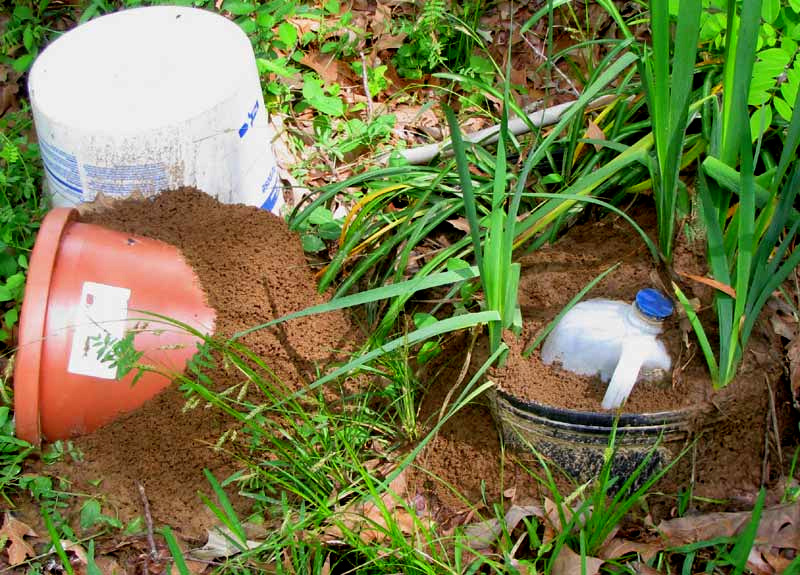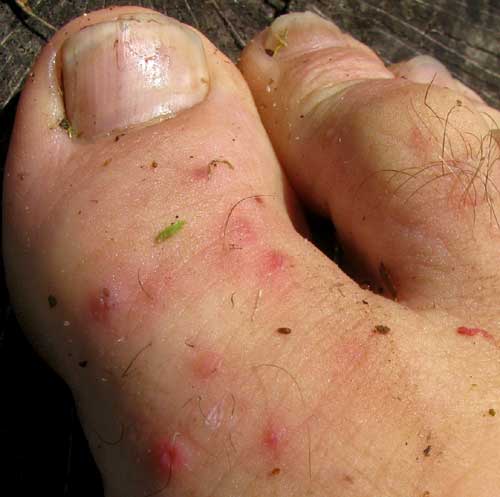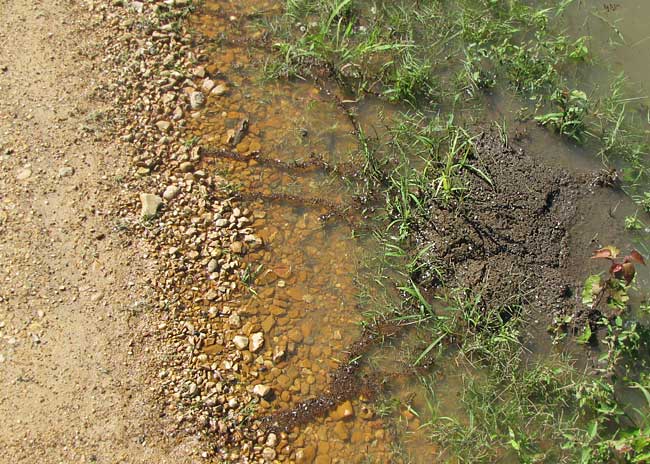Excerpts from Jim Conrad's
Naturalist Newsletter

from the April 8, 2012 Newsletter, issued from the forest near Natchez, Mississippi; elevation ~400ft (120m), ~N31.47°, ~W91.29°:
FIRE ANTS
All here is not fresh, lush greenness, honeysuckle fragrance and birdsong. There are Fire Ants, and plenty of them. If you leave a bucket on the ground, before long a colony establishes itself there. Two colonies in a random, neglected backyard spot are seen at the top of this page.
You can examine the genuine, dew-wet, morning-walk-soiled, fire-ant-stung toe of a barefoot hermit below:

Those red spots itch like crazy all through the night.

As the swamp's waters rise, fire ant nests along the gravel roads are flooded, as shown above. In that picture the dark brown mass at the right is the top of an almost submerged fire ant nest. The dark lines connecting the nest with the gravel road are ant-body bridges consisting of very many female worker ants linked together atop the water, enabling larger, winged ants to walk over them, as shown below:

I don't know whether the winged ones are male drones, female potential queens, or a mixture. If you look closely you can see that some workers carry white pupae in their mandibles.
Red Imported Fire Ants, which I assume these to be, are SOLENOPSIS INVICTA, native to South America. During my hermiting years near here my Newsletters were full of fire-ant stories, especially how they stung me as I gardened in fire-ant-infested ground. In fact, in taking the two above pictures I managed to get stung in about 20 places, but I was glad for the inoculation. My first sting many years ago resulted in awful, running, itching sores, but eventually I developed enough of an immunity to them that now they cause no more than a burning sensation that quickly passes, usually leaving no bump at all. I just need to be stung occasionally to keep up my immunity.
from the June 26, 2002 Newsletter, issued from near Natchez, Mississippi:
FIREANTS AFTER A RAIN
I wage a continual battle with fire ants. Fire ants were introduced into the US in 1918, and since then their distribution has expanded over a huge part of the country, driving out many native species, causing untold suffering to animals with their stings, and causing my ankles and wrists as I write this to be speckled with itching, whitehead-like pustules resulting from their stings.
Thursday afternoon a good storm came up so just as I was hearing the rain's roar coming through the woods I chopped open a fire ant nest next to my trailer, with the hope that the deluge would drown the colony. Soon a little torrent of runoff swept before me as I stood in the outdoor kitchen watching. Thousands of white fire ant pupae and larvae swept before me. When the rain ended and the water soaked into the ground, the high-water mark beside my kitchen was outlined with a rim of white ant-pupae bodies. I do not like hurting living things, but in this camp it's either them or me. During my first year here, they almost won.
At dusk two hours later I noticed that the ground had been cleared of white pupae and larvae. Looking closer in the twilight I saw slow-moving lines of fire ants, each ant carrying a pupa or larva, and the lines converged at the old nest where already fresh excavations were taking place.
Looking down at those ant lines I felt like a chastened god, a god who had wrecked havoc upon a nation with war and pestilence, and now, seeing the grim, heroic, single-minded determination of the trudging victims, felt obliged to grant them respect. I regretted that I had been the cause of their misery, which in the dark, mud-smelling wetness of that dusk was profound.
It is not the character of each ant that I admire, for I remember that an ant hasn't brains enough to possess much character at all. It is the essence of the life-struggle in us all to which I grant my awe and respect.
from the December 9, 2001 Newsletter, issued from near Natchez, Mississippi:
FIREANTS AFTER THE RAIN
Fire ants can't handle wet soil. After last week's deluges, this week many fire ant colonies have shifted to higher ground, and some have moved into relatively dry, dead, crumbly tree stems and trunks, in which they have constructed tunnels and chambers just as they do in the soil. Thus twice this week while in the woods I have brushed against decaying stumps and snags with the result that hundreds or thousands of fire ants fell upon me, and then each ant began doing its best to inject its venom into my skin. On each occasion I had to undress completely and return home naked, once through blackberry brambles nearly as bad as the ants. It takes too long to pick each attacking ant from such ant-dusted clothing. It's best to just hang the clothing someplace and let the ants wander off after they've exhausted their biting impulses.
Several of this Newsletter's subscribers have Australian email addresses, and I know that recently fire ants were discovered becoming established in that country. I am sorry to say that if right now you in Australia could feel how my skin itches, and see the hundreds of white pustules erupted on my skin, you would glimpse your own future. I don't think you will have much luck stopping these ants' advancement across your land.
from the July 11, 2004 Newsletter, issued from near Natchez, Mississippi:
FIREANT BITES
About once a day I get stung by fire ants. People, especially gardeners, living outside the Deep South just don't know how lucky they are not having them.
I've experimented a good deal with treating my bites but I'm not sure I'm any wiser now than at the beginning. Early on I got the notion from someplace that when a fire ant stings you it injects acid beneath your skin, and this acid simply kills tissue so that an itching pustule results. Consequently it occurred to me to keep a box of baking soda handy, the idea being that if immediately upon being stung, if I very vigorously and roughly rubbed soda into the bites, the acid would be neutralized and the bites wouldn't hurt or develop pustules.
Moreover, this treatment seemed to work!
I had planned to announce my wonderful discovery in this Newsletter, but after doing some background study, suddenly I'm not so sure about my treatment. The problem is that fire ant venom turns out to be something other than an acid. One smart-looking website assures us that fire-ant venom is mostly "aqueous protein fractions," while another just as authoritatively asserts that it is "non-protein and contains dialkylpiperidine hemolytic factors (not acid)."
I wonder if anyone out there has a fire-ant-bite treatment that works? If you get bitten and don't know anything else to do, how about rubbing some baking soda onto the bites to see what happens? When I do it I scratch it in with my fingernails, making sure as much of the venom as possible is squeezed out, and as much baking soda as possible gets rubbed into the stings. Though baking soda appears to work with me, maybe what's really happening is that after so many years of frequent biting I've just developed an immunity, and the baking soda is doing nothing. I certainly don't react to chigger and mosquito bites the way I did as a kid. Now those "bites" hardly affect me at all.
By the way, fire-ant venom is injected with a stinger on the ant's rear end. Fire Ants do bite with their jaws, but the bites introduce no venom. It looks to me as if they're just getting a good hold so they can really dig that stinger at the other end deep into your poor skin.
Finally, in a recent issue of National Geographic the woodpecker known as Northern Flicker was profiled, and it was emphasized that flickers mostly eat ants. Well, I've always wondered why we have so few flickers around here because in Kentucky flickers were among the most common woodpecker species. Could it be because fire ants have driven out most of the native ants and flickers don't eat fire ants? Are flickers common anyplace where fire ants are thick? If anyone has an insight, please let me know.
from the September 9, 2001 Newsletter, issued from near Natchez, Mississippi:
WET FIRE ANTS
Last week I reported that our recent heavy rains seemed to have quieted the fire ants. Those ants stayed quiet only while it was raining.
Monday morning as always at dawn the first thing I did was to put on my jogging shorts. While tying my shoes I realized that my private parts were under attack. Fire ants had climbed my kitchen's poles, crossed a rope, and set up residence in my shorts that were hanging there. After my jog I found fire ants working in the ashes of my cooking fire, so while fixing breakfast I had to pick ants from my knuckles. Another colony worked in the ashes at my feet, so my toes and ankles got attention, too. By the end of the day I itched in many exotic places, in many unholy ways. In two days much of my skin looked like hamburger, and perpetually itched, and I'm itching now.
For me fire ants are more of a discomfort than the hottest Mississippi temperatures and the most suffocating humidity. Ten months of the year my feet and ankles itch from their bites, which cause whitehead-like pustules that burst and spend a long time in a semi-infected state.
Fire ants do not make themselves more endearing by being foreigners invading our territory. In 1918 fire ants were introduced into the Mobile, Alabama area, apparently from South America, and how they spread during subsequent decades. Today they occur as far north as the Tennessee/Kentucky border and southeastern Virginia.
Despite the aggravation they cause, fire ants are profoundly interesting. In their nests you find queens and workers, plus male and female members who can fly and mate. Large nests can have 240 thousand ants in them. Fire ants cannot eat solid food, and must extract or liquefy the food source, and this may explain why they like my campfire ashes so, for sometimes my cooking oil catches on fire and splatters there.
During my years at Laurel Hill I've reduced the numbers of fire-ant colonies in the gardens to a fraction of what was there earlier. I use several tricks. First, sometimes I shovel into a nest and carry as many ants and larvae as possible to a nearby woods and toss them in as diffuse a spray as possible into the darkest, moistest part of the woods. Fire ants need a certain concentration of individuals do survive, so spreading them out keeps them from coming together to nest, plus they need dry, disturbed areas, and cannot survive for long in moist natural forests.
This only weakens the colony, however. The main way to put an end to a nest is to soak it repeatedly. First stir it up with a shovel, then remove the nozzle from a hose, poke the hose deep into the nest, and turn the water on full blast. The next day you'll see that many ants have survived and that they are digging again, so you must perform the same operation. The next day there'll be just a few ants. Do this operation until there is no new sign of tunneling -- loose dirt around holes at the surface.
This works despite the fact that I've often seen fire ant colonies survive that had been submerged under floodwater for days. Maybe a bubble of trapped air in their nest keeps them alive -- I don't know. This may be the reason why you must shovel the nest before poking a hose into it, to break up any structures needed for bubble forming.